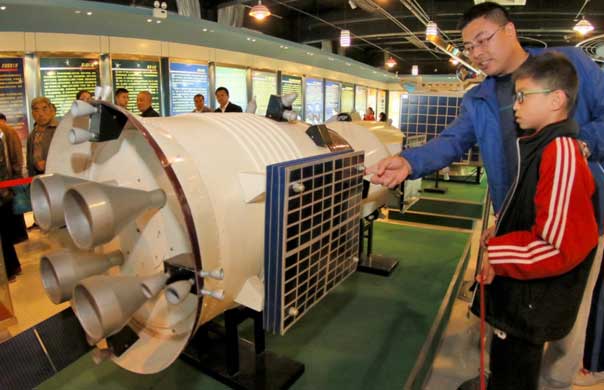.
 |
| In April 2017, citizens are watching "Shenzhou" spacecraft model, learning the knowledge of space and the achievements of Chinese space development in Yantai, Shandong province. Photo from People's Daily website |
China is expanding its “circle of friends” among the Belt and Road countries by taking anactive role in serving those countries with advanced space technologies.
Taking the development opportunity brought by the Belt and Road Initiative, China hasaccelerated the construction and application of the Space Information Corridor in terms ofearth observation, communications and broadcast, navigation and positioning.
To date, the country has signed 98 inter-governmental and inter-departmentalagreements with 30 countries and 3 international organizations, including 23 pacts with 11 countries along the route. Sound cooperation mechanisms to promote governmental andcommercial cooperation have also been established.
China has primarily formed a satellite communication service system composed of fixedcommunication broadcast, mobile communication and data relay.
It has 17 orbiting communications satellites for civil and commercial use and nearly 300 transponders to extend service to countries in South Asia, Africa, Europe and America.
The country, so far, has delivered communication satellite services to 30 countries andregions around the globe.
For instance, the China Brazil Earth Resources Satellite, a series of remote sensingsatellites, has provided data for territorial resources surveys, forestry, agriculture andother sectors for South American countries.
China has also launched the Fengyun weather satellite series to receive and distribute datafor 19 countries such as Indonesia, Laos and Thailand. The satellites have proven effectivein meteorological monitoring as well as in disaster prevention and control.
The country is constantly improving its satellite navigation system as well. The Beidousystem, for instance, can give ASEAN countries located in low latitudes a precisepositioning of around 5 meters.
Additionally, China has eyed major breakthroughs in satellite navigation sector viacooperation and exchanges with countries and regional organizations like Russia, India, Pakistan, Thailand and Indonesia. The country’s satellite navigation system is scheduledto cover all countries along the Belt and Road by 2018.
China’s space technology achievements are serving the Belt and Road countries via a seriesof specific projects.
Huang Shaobin, director of data application center of Headquarters Association of Asia-Pacific Economic Trade Limited, said that China’s remote satellites have played animportant role in agricultural monitoring and disaster prevention and control for ASEANcountries.
The satellite data have proven useful for logistics management application in Cambodia, precision management in Laos’ agriculture and forestry industries, as well as precisionmanagement and operation of Singapore’s ports, Huang added.
A national planning for future civil space infrastructure has indicated that 20 or morecommunication satellites will be developed and sent to the space.
Currently, the China National Space Administration is discussing possibilities for anetwork featuring space and ground integration, which is expected to enormously boostChina’s capability to providing satellite service to the Belt and Road countries.
Quelle: People's Daily
